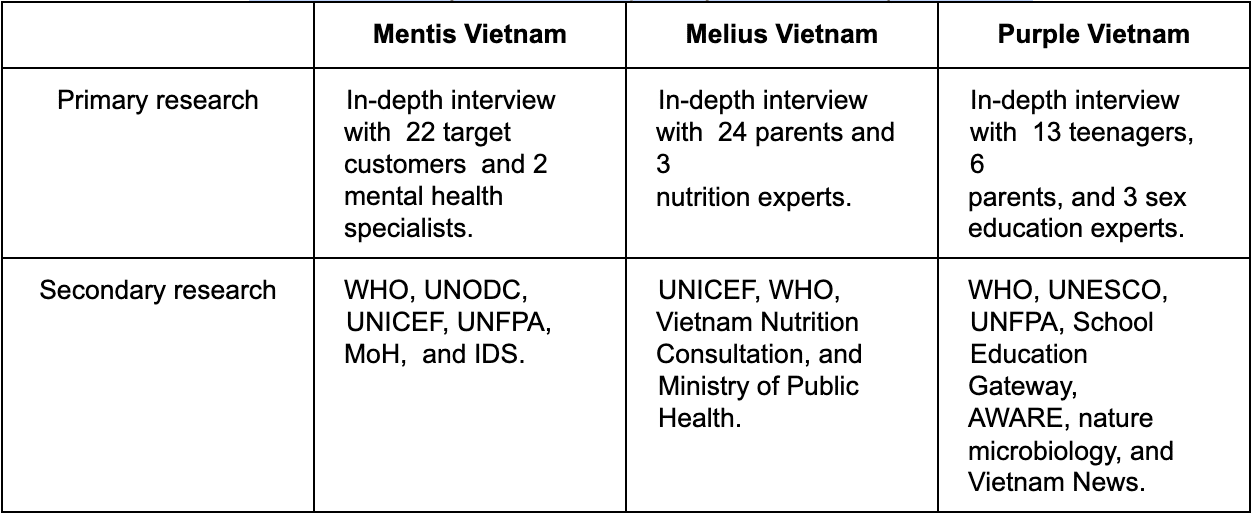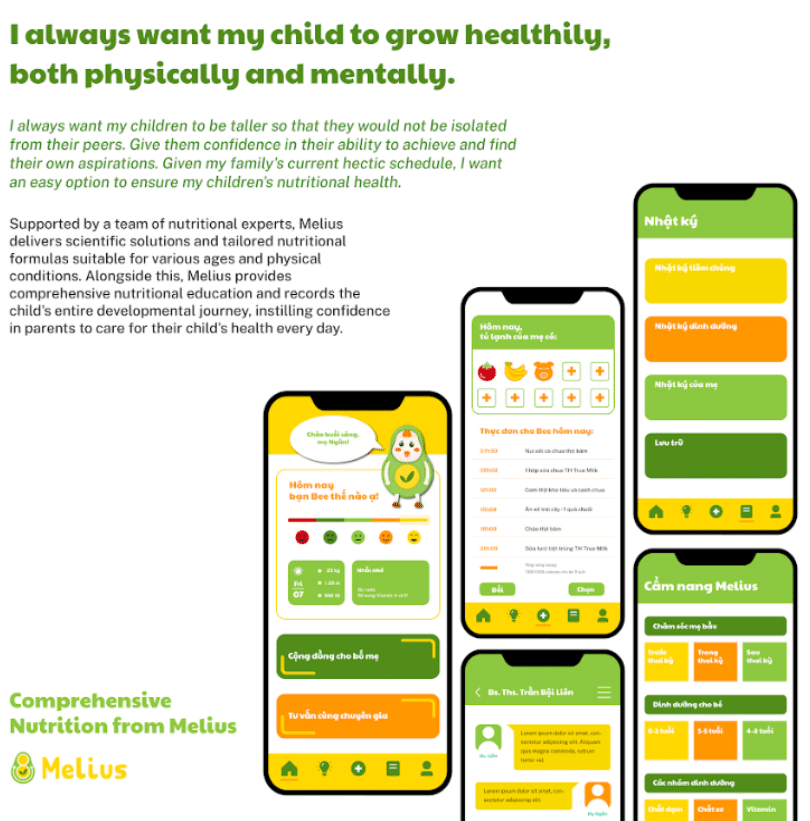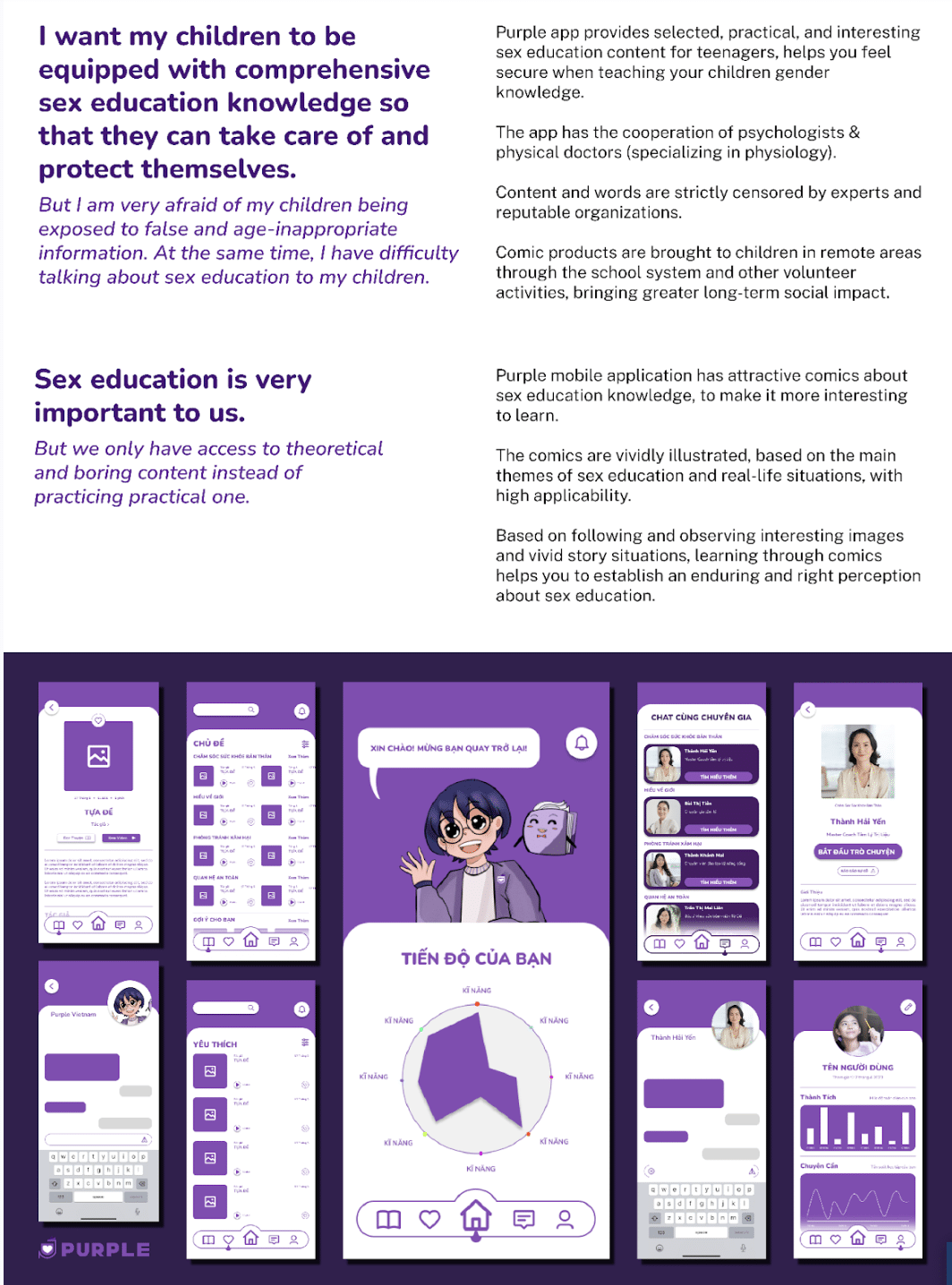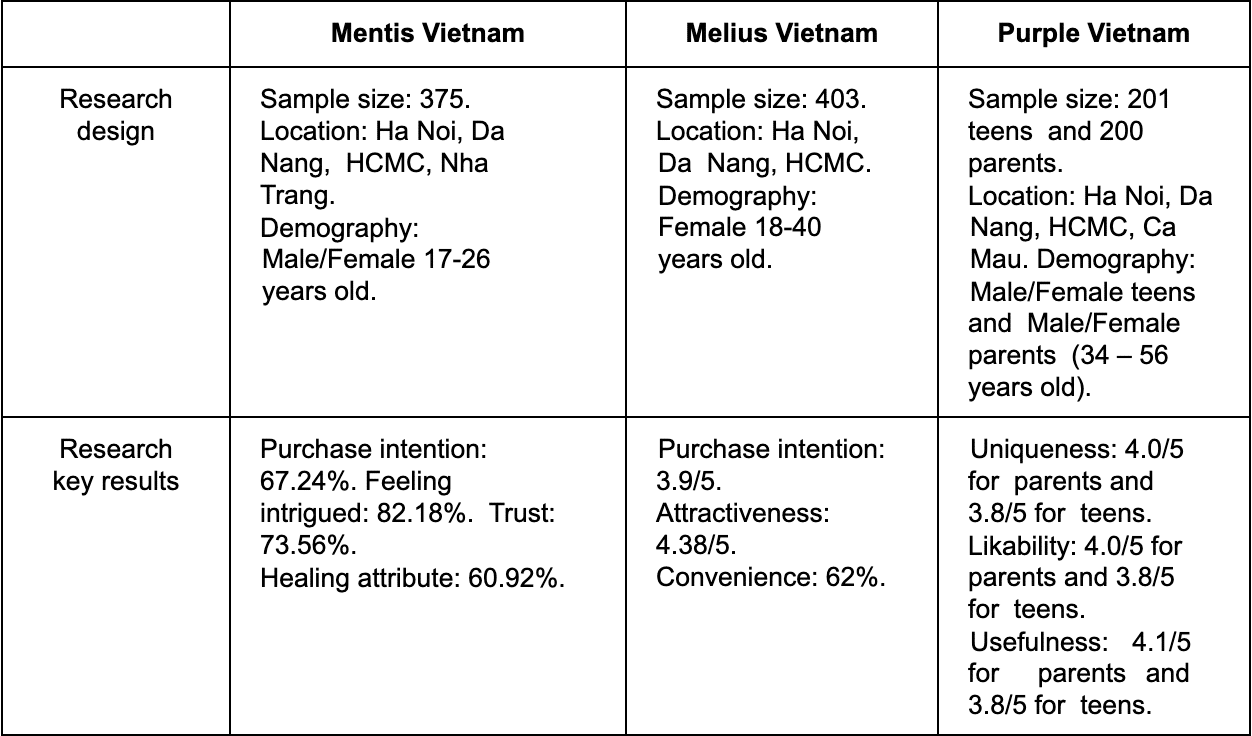SBC101 case
TRAN Xuan Linh, Greenwich University (Vietnam), Coach
DINH Thi Yen Nhi, Safe Place Vietnam
TON Nu Bao Ngan, Safe Place Vietnam
DUONG Quynh Anh, Safe Place Vietnam
NGUYEN Thien Ngan, Safe Place Vietnam
NGUYEN Tan Sang, Purple Vietnam
PHAM Nguyen Bao Chau, Mentis Vietnam
LE Phan Minh Huy, Melius Vietnam
NGUYEN Tien Dat, Eco Roof Vietnam
NGUYEN Thi Diu, Viet Hoi Nhap
PHAN Kieu Duyen, TEA Vietnam
BUILDING UP SOCIAL INNOVATION IDEAS FROM SCRATCH!
THE CASE STUDIES OF MENTIS, MELIUS, AND PURPLE VIETNAM
“I believe that the “Social Business Creation” global competition is an incredible platform for aspiring social entrepreneurs to showcase their ideas and gain valuable insights and feedback from experts in the field.”
– Tran Xuan Linh, Business Lecturer, Greenwich University (Vietnam) –
Xuan Linh, a lecturer at Greenwich University (Vietnam) and an alumnus of the “Social Business Creation” – a global competition organized by HEC Montréal University (Canada), IDEOS Social Impact Hub (Canada), and The Yunus Center (Bangladesh) with the vision to be the global leader in social entrepreneurship education, was the first runner-up in this competition’s 2019 edition. Inspired by how different universities and projects have created social impacts through the competition, he started his journey to become a young leader in social entrepreneurship education to inspire young people towards social impacts.
As part of his efforts to support social entrepreneurship, Xuan Linh has coached several social business startups in the 2022 and 2023 editions, including Mentis, Melius, and Purple Vietnam. This case study will analyze the process of creating these social business ideas from scratch and highlight challenges and successes in this journey. This case will also be used as a teaching case to demonstrate how to build a social idea from zero. After reading this case, students should be able to understand various techniques, frameworks, and tools for creating positive changes through the examples of three different social projects.
The first two weeks: starting with WHY.
Mentis, Melius, and Purple Vietnam’s story began with Xuan Linh, the coach, and only four students from Greenwich University (Vietnam) and one from the University of Economics (HCMC). In their first meeting, the core members were inspired to appreciate the significance of their upcoming social entrepreneurship journey. Learning from Stephen Covey’s book “The 7 Habits of Highly Effective People”, they began “with the end in mind” and discussed the final objective of the journey. In addition, through different academic concepts, the team established a solid social entrepreneurship foundation.
The definition and value of social entrepreneurship (Module 1.4 and 2.1 – Course SBC101: Principles of Social Innovation) were discussed during the first meeting. The recognition of social businesses is significantly increasing (Halberstadt and Kraus, 2016; Sutter et al., 2019; Von der Weppen and Cochrane, 2012), resulting in positive societal changes (Rao-Nicholson et al., 2017) while also achieving economic values for companies (Battilana & Dorado, 2010; Moss et al., 2011). Social entrepreneurs are essential to addressing social needs that conventional enterprises and governments cannot fulfill. Social entrepreneurship has also been a change agent in achieving the United Nations’ Sustainable Development Goals (“SDGs”) (Rahdari et al., 2016).
The next two months: following the core of social entrepreneurship. (Module 4.2 – Course SBC101: Principles of Social Innovation)
Identifying the social problems
With a better understanding of the significance of social entrepreneurship, particularly in contributing to the United Nations’ SDGs, the team has adopted a proactive approach to identify and address specific SDGs that align with the social and economic challenges prevalent in Vietnam as the base to think of social ideas. Some of the techniques applied during this brainstorming period include:
• Observation with curiosity (Module 3.5 – Course SBC101: Principles of Social Innovation): we recognize the significance of curiosity in fostering innovation and creativity. As social entrepreneurs, we should remain curious and continuously seek new knowledge and experiences. In addition to reading and specialized training, we learn through observation, reflection, and interaction. The core team was required to spend a significant amount of time observing and listening to the stories and lives of those around them to understand their pain points and the problems they faced in relation to the SDGs and challenges in Vietnam.
• Ethnographic research (Module 3.5 – Course SBC101: Principles of Social Innovation): this approach is beneficial for social entrepreneurs who seek to understand the needs and experiences of different groups of people in order to develop solutions that address their problems and promote social change. The core team was motivated to use various methods, such as interviews and participant observation.
• Intentional search (Module 4.4 – Course SBC101: Principles of Social Innovation): we conducted extensive research and analysis by collecting secondary data from reliable sources such as the World Bank, The World Trade Organization, World Health
Organization, the United Nations Educational Scientific and Cultural Organization, HCDC Vietnam, and the Vietnam General Statistics Office.
• Insight from personal experiences, hobbies, accidental discovery, and awareness generated by media, personal and professional networks (Module 4.4 – Course SBC101: Principles of Social Innovation): team members were asked to seek ideas through every daily activity they involved.
After one week of intensive research, more than 20 social problems and their first solutions were identified in connection to specific SDGs and relevant socio-economic situations in Vietnam.
Evaluating social ideas
When selecting the best social ideas, it is important to consider several features of social innovation (Module 3.1 – Course SBC101: Principles of Social Innovation). The idea should generate a positive social impact, be driven by both social and economic motivations, be novel, scalable, and sustainable, and can take different forms (Michelini and Fiorentino, 2012). Additionally, according to Kickul and Lyons (2012), the prevalence of social problems or needs should be quantitatively demonstrated, and the aspiring entrepreneur should have the necessary knowledge, skills, and abilities to effectively solve the problem and launch the social venture. The solution should strike a balance between being too radical or too similar to existing solutions, with innovation and competitive advantages clearly elaborated. Urgency should also be considered, as the social problem may require immediate action, and accessibility, as traditional welfare mechanisms may not be effective in addressing the problem, allowing for a new solution through social entrepreneurship. By considering these features, the core team has narrowed down and chosen three social ideas that are also linked with the core team’s interest, namely Mentis, Melius, and Purple Vietnam. These initial social ideas are:
• Mentis Vietnam supports young people who are under hardship situations related to mental health.
• Melius Vietnam provides a useful nutrition solution for parents to take care of their children. • Purple Vietnam aims to construct a world where no more teenagers have to suffer gender trauma.
Reflecting deeper through system thinking
After having some initial social ideas, refining and strengthening them through a systematic thinking process (Module 3.3 – Course SBC101: Principles of Social Innovation) is essential. This involves identifying the root causes and consequences of the issue, understanding existing solutions and their impact, identifying gaps in the current system, and identifying leverage points for maximum impact.
These processes involve primary and secondary research to dive deep into the causes, understand existing solutions, and find impactful gaps to maximize social values.
Table 1: Summary of the teams’ primary and secondary research

After understanding the root causes of the social problems and available solutions and their impacts, the core team applied the Canvas Impact Gaps model (Module 3.2 – Course SBC101: Principles of Social Innovation) to identify the impact gaps and improve the initial solutions:
• Mentis Vietnam addresses mental health problems by providing a secure and encouraging digital environment for stress-relieving activities, mood tracking, community support, and related courses. It offers a comprehensive and supportive solution for young people in hardship situations related to mental health, following Goal 3 and Goal 10 of UN Goals.
• Melius Vietnam is designed mainly for parents who are having difficulty designing nutritious meals for their children or need to improve their nutrition knowledge. With the integration of various features, Melius provides a valuable solution for parents to care for their children.
• Purple Vietnam provides teens with a mobile learning app with sex education content through comics and chats with AI and experts. It gains parents’ security and trust through positive words, sharing workshops, and the companionship of experts.
Justifying and reframing social ideas
To verify the soundness and potential impact of these social innovations, the core team designed different concept boards for testing using quantitative research. These concept boards typically include three key elements: target insight, social innovation execution ideas, and reasons to believe.
Picture 1: Concept board of Mentis Vietnam

Picture 2: Concept board of Melius Vietnam

Picture 3: Concept board of Purple Vietnam

Table 2: Summary of concept board testing results

Based on the concept board testing results, our targeted customers have well perceived our ideas. This is an exciting step forward in the development process, and our concepts are ready to be further implemented.
Throughout the journey: building team and the ecosystem.
In the beginning, there were just five members and a coach. However, through hard work and dedication, the team has grown significantly. It now includes four departments with more than 40 members from 10 universities in Vietnam’s North and South regions. During this journey, the core team has performed stakeholder analyses and obtained support from more than 500 stakeholders, including investors, mentors, experts, community members, and potential customers. This high level of support has been meaningful in making the team refine social innovation ideas and develop practical solutions to suit their target customers. We have eventually learned the importance of a diverse team with different backgrounds while serving the same mission to create social impacts (Module 2.4 – Course SBC101: Principles of Social Innovation).
The team strongly believes social entrepreneurs can make a real difference and create significant social impacts together. We recognize that by working together and supporting one another, they can achieve an even more significant impact and promote positive change on a larger scale. The core team has connected to some of the other teams, including Safe Place Vietnam, Eco Roof Vietnam, Viet Hoi Nhap, Glocal IELTS, SpiritUP, TEA Vietnam, Caress, and Kick-it-off. Through collaboration and mutual support, these teams have demonstrated the power of social entrepreneurship to drive innovation and create positive social change.
Conclusion
The case study focuses on creating social business ideas, specifically from the cases of Mentis, Melius, and Purple Vietnam, from scratch. The team began with a solid social entrepreneurship foundation and identified Vietnam’s social and economic challenges. Several techniques were used to brainstorm and evaluate social ideas, and the team narrowed down to three ideas based on the features of social innovation. Systematic thinking processes were used to refine and strengthen the ideas. We hope that students know how to start a social project and apply different knowledge, in this case, to create positive social impacts.
Appendix: List of applied modules from Course SBC101: Principles of Social Innovation
Module 1.4 – Value of social entrepreneurship.
Module 2.1 – What is social entrepreneurship?
Module 2.4 – Success factors.
Module 3.1 – Defining social innovation.
Module 3.2 – Impact creation.
Module 3.3 – System thinking.
Module 3.4 – Mapping the ecosystem.
Module 3.5 – How to be innovative and creative.
Module 4.2 – The core of social entrepreneurial projects.
Module 4.4 – Social entrepreneurial opportunities.
Reference
Battilana, J., & Dorado, S. (2010). Building sustainable hybrid organizations: The case of commercial microfinance organizations. Academy of Management Journal, 53(6), 1419–1440.
Halberstadt, J., Kraus, S., 2016. Social entrepreneurship: the foundation of tomorrow’s commercial business models? International Journal of Entrepreneurial Venturing 8 (3), 261–279.
Kickul, Jill, and Thomas S. Lyons. 2012. Understanding Social Entrepreneurship: The Relentless Pursuit of Mission in an Ever-Changing World. New York and London: Routledge.
Michelini, L., & Fiorentino, D. (2012). New business models for creating shared value. Social Responsibility Journal, 8(4), 561–577. doi:10.1108/17471111211272129
Moss, T. W., Short, J. C., Payne, G. T., & Lumpkin, G. T. (2011). Dual identities in social ventures: An exploratory study. Entrepreneurship Theory and Practice, 35(4), 805–830.
Rahdari, A.; Sepasi, S.; Moradi, M. Achieving sustainability through Schumpeterian social entrepreneurship: The role of social enterprises. J. Clean. Prod. 2016, 137, 347–360.
Rao-Nicholson, R., Vorley, T., Khan, Z., 2017. Social innovation in emerging economies: national systems of innovation-based approach. Technol Forecast Soc Change 121, 228–237.
Sutter, C., Bruton, G.D., Chen, J., 2019. Entrepreneurship as a solution to extreme poverty: a review and future research directions. Journal of Business Venturing 34 (1), 197–214.
Von der Weppen, J., Cochrane, J., 2012. Social enterprises in tourism: an exploratory study of operational models and success factors. Journal of Sustainable Tourism 20 (3), 497–511.

